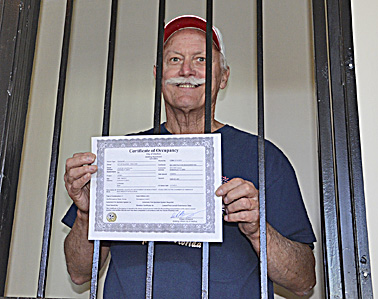
CARL MCKINNEY/Alachua County Today
Mayor Gib Coerper shows off the certificate of occupancy. He posed in the jail cell, a remnant of the building's history as a police station.
ALACHUA – Years in the making, the renovation for the Community Welcome Center in Alachua has finally hit a milestone.
The building, situated in downtown Alachua, is now up to code, complete with a certificate of occupancy from the city’s building inspector.
The welcome center, which was formerly a post office and then a police station, has been in the works since around 2006 or 2007, when the Chamber of Commerce began the project.
“We envision it as a place where people who are visiting can stop in and learn about the local community,” said David Flinchum, chamber president, in an earlier interview.
It will serve as a tourist information center and as the main office for the chamber. It will provide information on local businesses, and will also feature displays and exhibits from the Alachua Historical Society.
With help from the community, the chamber expects the welcome center to formally open in mid-January, said Linda Rice Chapman, chamber member.
Sandy Burgess of Precision Metals donated the railing system, Hugh Cain of Allstate will supply some office furniture and Lowe’s of Alachua supplied all the exterior paint.
The building was essentially gutted, Chapman said, as it needed a complete renovation.
Until the welcome center is complete, the Chamber of Commerce will continue to be based out of a small office at Alachua Elementary School.
With a new headquarters on Main Street, the chamber can operate more visibly, said previous chamber president David Pope.
“It gets the chamber out front where it can be seen,” he said.
The biggest issue so far has been funding, current president Flinchum said in a May interview.
The chamber received a grant in 2011 from the county’s Tourist Development Council for $25,000. It got another $25,000 from the Alachua Downtown Redevelopment Trust Board.
When the chamber applied for the next phase of the grant this year for another $25,000 from the council, it lost out to the City of Alachua.
“Right now, we’re broke,” Chapman said.
To raise the money to finish the project, the chamber has two fundraisers on the immediate horizon.
The first is a patronage program. Donators can sign up to be a patron of the museum that will be inside the welcome center. Patrons will be honored with a permanent plaque with their names prominently displayed on the museum walls.
The second fundraiser allows people to purchase spots on the chamber’s calendar, effectively letting them “buy the day,” Chapman said. It would come with a signed proclamation from Mayor Gib Coerper declaring the day in honor of whoever bought the spot. For smaller amounts of money, the plan is to allow citizens to memorialize birthdays, anniversaries and other special personal events.
There’s still a long way to go for the project, said former president Pope, even though the building is finally up to code.
Chapman walked through the building, explaining what kinds of renovations are still in store.
The bathroom tiling still needs to be finished, there are no furnishings or display cases yet and the exterior needs to be painted and landscaped. Security lighting and signage are also part of the plan, if and when the funding allows it, Chapman said.
“The outside is virtually untouched,” she said.
Local architect Paul Stresing donated his time to help, drawing up big plans for the center.
The building is a concentrated effort from the Alachua economic community to move the city forward by bridging tourism, history and business, Chapman said.
“This building is going to have the power to transform Main Street,” she said. “That can only have the effect of making Alachua more prosperous.”
# # #
Email cmckinney@
alachuatoday.com
Add a comment


